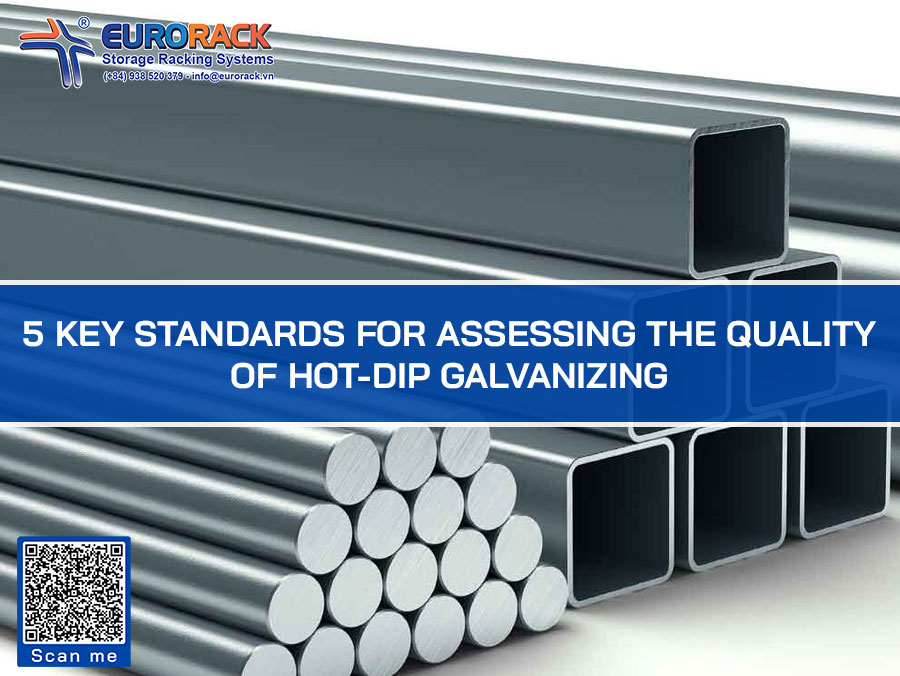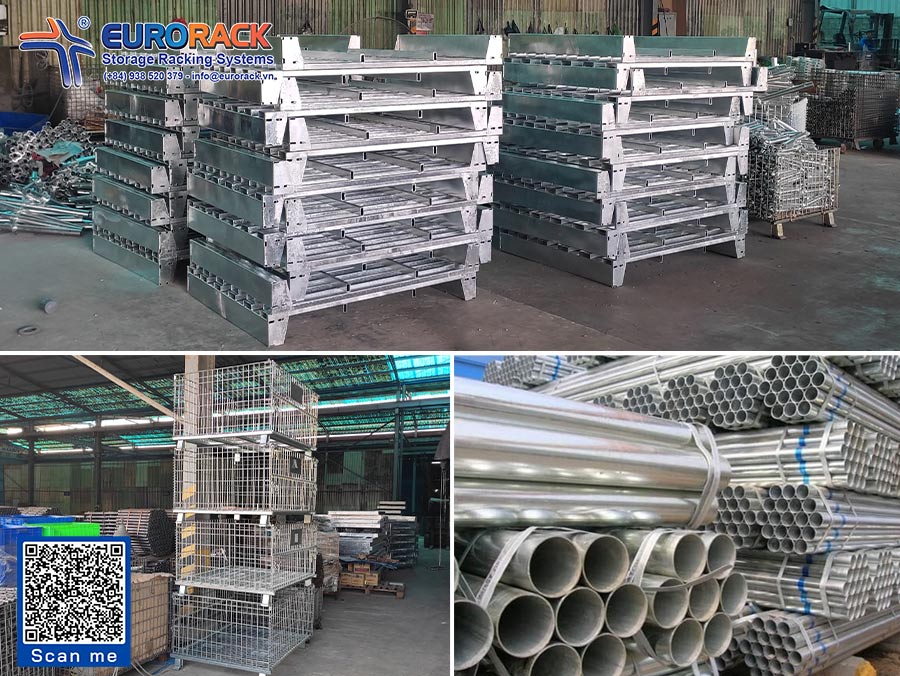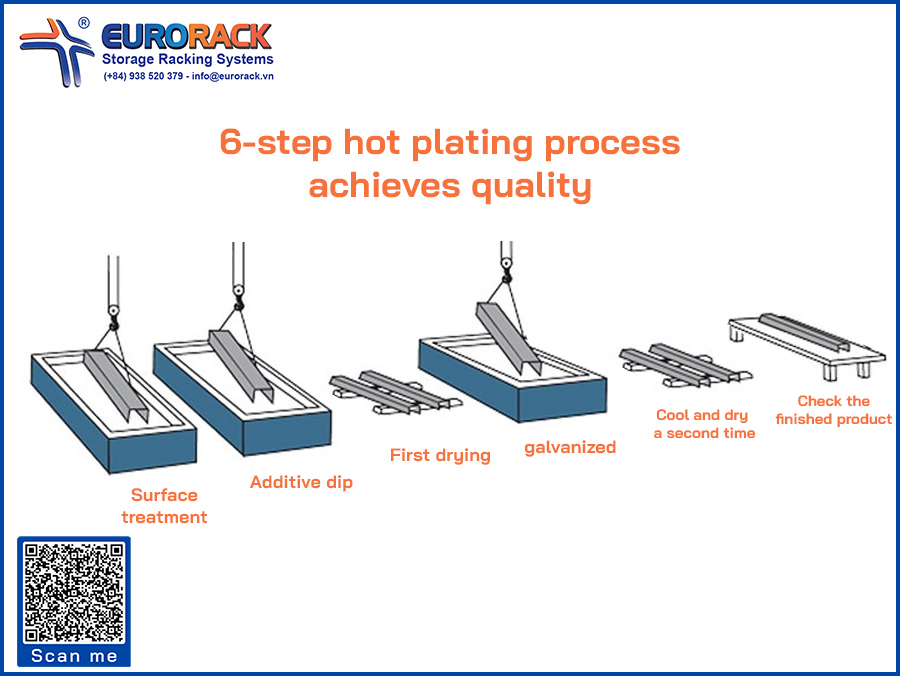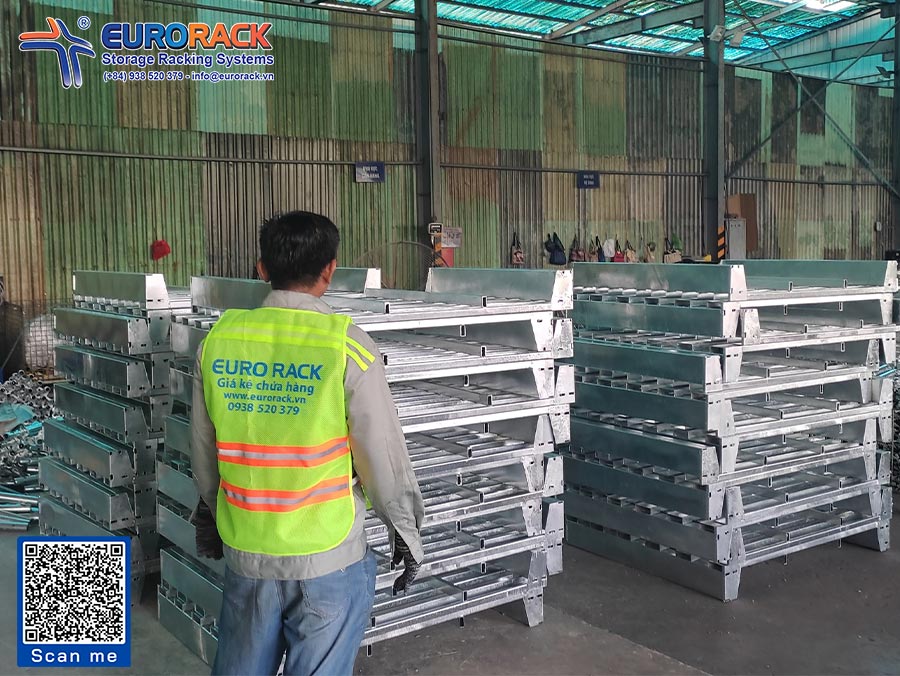- Hotline: (+84) 938 520 379
- Email: info@eurorack.vn

Exploring the Technical Standards for Evaluating Hot-Dip Galvanizing
Hot-dip galvanizing is a method of protecting metal items from elements that could affect their surface quality. This process involves dipping the metal object into a vat of molten zinc at approximately 420 degrees Celsius. As a result, the metal surface is coated with a durable layer of zinc that is very difficult to peel off, potentially extending the product's lifespan by decades.
This idea was conceived by a French chemist who, after extensive research into the technique, realized it was an excellent way to protect metal surfaces. However, it was nearly 100 years later that another chemist successfully executed this method and patented it. Soon after, the process of hot-dip galvanizing spread widely and became commonly used in the iron and steel industry in Britain and around the world.
To this day, hot-dip galvanizing is the preferred choice for protecting metal components, offering the best technique to extend the lifecycle of steel products unmatched by any other method.

The concept of using zinc plating to protect metal surfaces originated from a French chemist.
Executing hot-dip galvanizing is not overly complex, yet achieving a more durable and peel-resistant zinc layer requires adhering to a specific process and regulations. Below is the standard procedure in mechanical zinc plating.
This step involves cleaning the metal surface before galvanizing, as iron and steel materials often arrive covered in dirt, iron filings, and a layer of grease – all of which can cause the zinc layer to peel off easily, even with slight contact.
To enhance adhesion and durability, the object will be processed using one of the following basic methods: sandblasting with high pressure, degreasing with high-pressure water jets, dipping in chemicals for cleaning, or manual cleaning.
Oxide, a chemical compound, forms on the metal surface beforehand. Without removal, the metal surface will eventually decay and disintegrate due to oxidation. Moreover, if the oxide removal step is skipped, the metal object, despite being galvanized, will still corrode from within when oxidation reaches a high level, causing the zinc layer to start peeling.
Currently, the most effective and widely used method to inhibit metal corrosion is dipping the metal to be galvanized in a dilute Sulfuric Acid solution, thereby ensuring the zinc coating firmly adheres to the object, creating a durable and long-lasting protective layer over the years.
After completing step 2, the product is first air-dried (either outdoors or in a specialized drying room) to prepare for the galvanizing step.
Zinc metal is melted at a relatively high temperature compared to the boiling point of water, at 420 degrees Celsius. Your metal product will be immediately covered after being dipped into the molten zinc vat, enveloping both the inner and outer surfaces (if the material is of iron, steel in box or pipe forms). This dipping step can be repeated from 2 – 5 times and more, depending on the desired thickness of the zinc layer.
After dipping, the product surface is very hot, and the zinc layer has not completely adhered to the metal surface. Therefore, it needs about 2-5 hours to dry and ensure a strong bond between the two metals.
Finally, you just need to thoroughly review and ensure the product surface meets quality standards such as uniformity, glossiness, and thickness. This helps you make further decisions on whether to stock the finished product or proceed with re-galvanizing.

6-Step Quality Standard Process for Hot-Dip Galvanizing
In the galvanizing process, each unit and customer has specific requirements for the objects to be galvanized, whether they are iron pipes, steel sheets, cast iron, black materials, etc., along with many other factors. Therefore, currently, there are 5 standards used to assess the quality of hot-dip galvanizing.
One of the leading standards for evaluating industrial products, including metal surface treatment engineering. Established by the British Standards Institution (BSI), this standard has been recognized and valued globally after a century. Achieving this standard also offers manufacturers a significant opportunity to enhance their market competitiveness. Below are some notable BSI standards:
The ASTM standard set is the world's first issued to measure, evaluate, and certify the quality of hot-dip galvanized products. This standard operates and certifies across 15 fields, including stainless steel. Below are some notable stainless steel industry standards:
An international standard for quality management systems. For the hot-dip galvanizing process, ISO 9001 standards ensure that the production process is carried out according to quality requirements, including raw material control, plating process, testing, and final product inspection. Currently, ISO 9001:2015 is the latest version of this standard.
JIS, short for Japanese Industrial Standards, sets rules and technical requirements for products and services. For hot-dip galvanizing, JIS standards emphasize controlling the thickness of the coating, durability, and corrosion protection properties of the zinc layer. Some basic JIS standards include:
These standards are used in Vietnam to assess the quality, safety, and performance of products. For hot-dip galvanizing, Vietnam standards focus on quality control of raw materials, plating methods, coating evaluation, and other related technological requirements. Some basic Vietnam standards include:
Warehouse management is a crucial activity in a business's journey, where good management stems from adhering to operational principles and equipping facilities to support safer and smoother management processes. Currently, two main devices present in almost every warehouse have applied the hot-dip galvanizing method to enhance the efficiency of storing and transporting goods in the warehouse. Below are some advantages it brings.

Eurorack galvanized pallets achieve high load capacity in warehouse storage, durable and rust-resistant
Hot-dip galvanizing creates a protective coating on the iron surface, helping to prevent rusting. This is extremely important in protecting iron pallets and racks from environmental effects, especially in high humidity and outdoor use, and in cold storage.
The zinc coating enhances the ability to hold heavier loads better, reducing damage and replacement due to bending or even structural changes on the product surface over long use, thereby effectively increasing the durability of iron pallets and racks.
During the process of storing and transporting goods in the warehouse, impacts due to negligence are inevitable, causing signs of scratches and dents, quickly degrading the surface of pallets or racks. The galvanizing method is an effective solution to this problem thanks to being enveloped by a thick and very sturdy zinc layer.
Thus, in addition to providing you with 5 common standards for evaluating the quality of galvanizing techniques, we also offer some information on the origin of the method that has been transmitted and developed strongly to this day. Galvanizing is not only suitable for devices in the warehousing field but also serves many other fields related to protecting metal surface structures. Stay tuned with us to receive the latest useful articles.
-------------------------------------
EURORACK MECHANICAL JSC
Hotline: 0938 520 379
Mail: info@eurorack.vn
Website: eurorack.com.vn
Address: No. 5/3 Doan Thi Diem Street, Ward 1, Phu Nhuan District, HCMC, VietNam